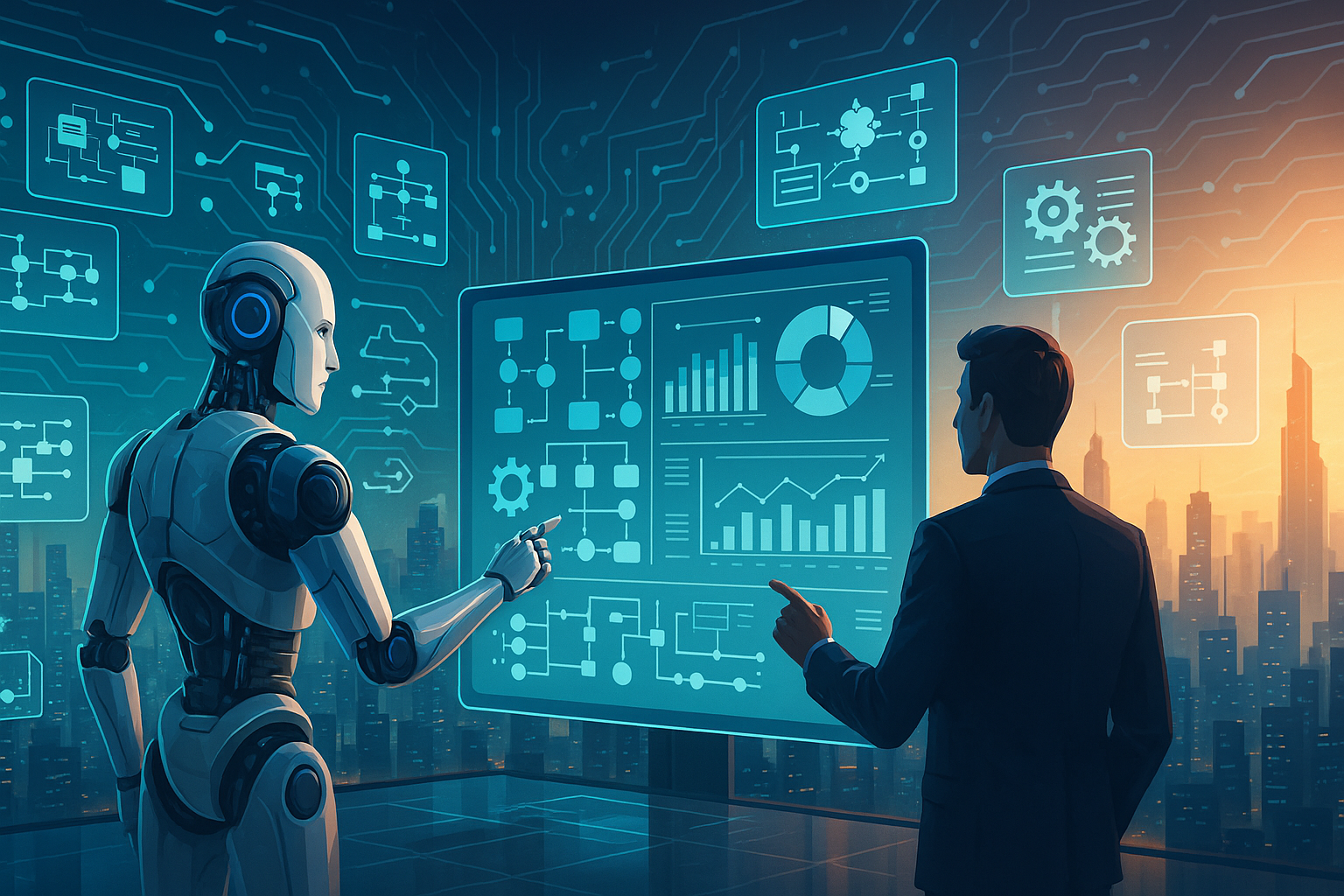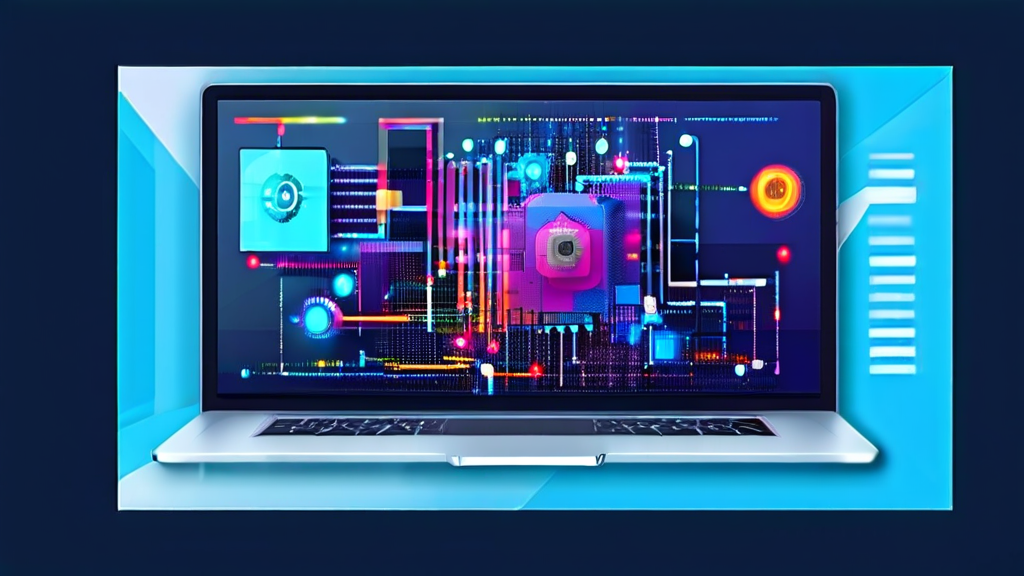Intelligent Process Automation Software (2025): Benefits, Features, ROI, and Top Tools
Definition: Intelligent process automation (IPA) software combines robotic process automation (RPA), AI/ML, and decision engines to automate multi-step workflows that involve documents, decisions, and exceptions—at scale.
What you’ll learn:
- How IPA works (RPA + AI + rules + integrations)
- Real-world ROI benchmarks and adoption trends
- Step-by-step implementation framework with pitfalls to avoid
- Top IPA tools in 2025 with comparison table
- Features checklist, security, and compliance essentials
- FAQs + schema for better Google & AI Overview visibility
AI-driven automation is moving from pilots to production. Leading analysts report that automation and gen‑AI together can add meaningful productivity growth at the macro level, while firms that deploy IPA internally see faster cycle times, fewer errors, and measurable cost savings (McKinsey, Deloitte, IBM).
Related guides on Key for Riches:
How Intelligent Process Automation Software Works
IPA integrates five building blocks:
- Robotic Process Automation (RPA): Software robots click, type, extract, and move data across apps—reducing manual steps.
- AI/ML: Document understanding (OCR + NLP), classification, predictions, and anomaly detection.
- Decision Management: Business rules + decision models (e.g., lending, claims, KYC) with auditability.
- Integrations: APIs, webhooks, iPaaS connectors, and event streams to ERP/CRM/DB/Cloud services.
- Analytics & Monitoring: Real-time dashboards for cycle time, error rates, cost per transaction, and SLA conformance.

This 2025 guide to intelligent process automation software explains how it works, the business impact, real ROI benchmarks, and the exact steps to implement it successfully.
| Layer | What It Does | Typical Tech | Outputs |
|---|---|---|---|
| RPA | Automates UI-level tasks | Bots, recorders, low-code flows | Clicks, keystrokes, data movement |
| AI/ML | Understands documents & data | OCR, NLP, classifiers, LLMs | Entities, labels, predictions |
| Decisions | Applies policy & risk logic | BRMS/DMN, rules, scorecards | Approve/deny/route with reasons |
| Integrations | Connects systems | REST, SOAP, iPaaS, webhooks | Read/write across apps |
| Analytics | Monitors & optimizes | Process mining, BI, alerting | KPIs, forecasts, recommendations |
Why Intelligent Process Automation Software Matters: Measurable Outcomes of Intelligent Process Automation Software: Before/After Benchmarks
- Productivity growth: Work automation combined with gen‑AI could add ~0.5–3.4 percentage points to annual productivity growth globally (McKinsey).
- Automation ROI drivers: Organizations deploy intelligent automation to boost productivity, reduce cost, improve accuracy, and elevate CX (Deloitte survey).
- Macro outlook: Longer-run potential ranges from ~0.8–1.4 pp productivity uplift from automation initiatives even apart from gen‑AI (McKinsey MGI (PDF)).
- Definition & scope: IPA blends AI, BPM, and RPA to scale decisions and workflows (IBM, IBM – Intelligent Automation).
Measurable Outcomes: Before/After Benchmarks
| Metric | Before Automation | After IPA | Typical Improvement |
|---|---|---|---|
| Cycle Time | 2–3 days | 2–4 hours | ~60–90% faster (process-dependent) |
| Error Rate | 5–8% | 0.5–1% | ~80–90% reduction |
| Cost per Transaction | $15–25 | $2–5 | ~70–85% lower |
Note: Benchmarks vary by process complexity, data quality, and integration depth. Cross-check with vendor TEI studies (e.g., Forrester TEI for Power Automate, Blue Prism, Automation Anywhere).
Where Intelligent Process Automation Software Delivers Fastest Wins
Step-by-Step: IPA Implementation Blueprint
- Finance: AP/AR, invoice capture, reconciliations, expense audits, loan origination/underwriting.
- Insurance: Claims intake/triage, FNOL document handling, policy admin, fraud flags.
- Healthcare: Prior auth, eligibility checks, coding/abstracting, revenue cycle.
- Retail/eCommerce: Catalog ops, order exceptions, returns, pricing, customer care.
- Manufacturing: Order-to-cash, supplier onboarding, quality checks, maintenance workflows.
- Telecom: Service activation, billing disputes, churn risk routing, network event handling.
Try an IPA pilot: 1 process, 4–6 weeks, measurable ROI.
Step-by-Step: IPA Implementation Blueprint
- Map demand & value: Inventory candidate processes. Score by volume, rules, data structure, exception rate, SLA pain, and business value.
- Select a narrow pilot: Choose 1–2 processes with high volume + stable rules. Define success metrics before you start.
- Design for humans-in-the-loop: Add review/override steps for edge cases. Capture rationale to improve models over time.
- Data readiness: Validate sources, fix duplicates, standardize fields, and label samples for document models.
- Integration first: Prefer APIs to fragile UI automation. Use webhooks/events for resilience.
- Security & compliance: RBAC, audit trails, least privilege, encryption, PII masking; align with HIPAA/SOX/GDPR as applicable.
- UAT & guardrails: Test at scale with synthetic & real cases. Rate-limit bot concurrency. Define roll-back plans.
- Scale & optimize: Move to a CoE model. Track percent automated, human touch rate, and time-to-recovery.
Top Intelligent Process Automation Software Tools (2025)
The RPA/IPA landscape is mature and competitive. Recent analyst viewpoints (e.g., Gartner Magic Quadrant Leaders) indicate sustained leadership among major platforms and a shift toward “agentic” AI features. Always verify with the latest MQ and Wave reports.
| Platform | Strengths | Ideal For | Notes |
|---|---|---|---|
| UiPath | End-to-end suite (RPA, document understanding, test, AI Center); broad marketplace | Enterprises needing breadth + governance | Consistently a Leader in MQs (check 2025 MQ) |
| SS&C Blue Prism | Strong governance, scalability, digital workers model | Highly regulated industries | Leader status noted in recent MQs |
| Automation Anywhere | Cloud-native approach, strong attended/unattended mix | Distributed teams, rapid scaling | Multiple TEI studies for ROI reference |
| Microsoft Power Automate | Tight M365/Azure integration; low-code workflows | Microsoft-centric orgs | Forrester TEI available for ROI modeling |
| IBM Process/Automation | BPM + RPA + decisions + observability | BPM-first and hybrid needs | Strong decision management lineage |
Analyst materials and TEI studies you can consult:
Gartner MQ (UiPath blog pointer),
Gartner MQ (Blue Prism pointer),
Forrester TEI – Power Automate,
Forrester TEI – Blue Prism,
Forrester TEI – Automation Anywhere.
RPA vs. Intelligent Process Automation Software: What’s the Difference?
Intelligent Process Automation Software Features Checklist: What to Look For
| Aspect | Traditional RPA | Intelligent Process Automation (IPA) |
|---|---|---|
| Data Types | Mostly structured | Structured + unstructured (docs, emails, images) |
| Logic | Rule-based scripts | Rules + ML/LLMs + decisions |
| Exception Handling | Scripted workarounds | Adaptive, human-in-the-loop, learning |
| Resilience | UI changes break bots | API-first + fallback UI + observability |
| Use Cases | Repetitive tasks | End-to-end processes with judgment |
Features Checklist: What to Look For
- Design & Dev: Low-code studio, reusable components, versioning, testing.
- AI/Docs: OCR + NLP, document classification, field extraction, confidence scoring.
- Decisions: Rules authoring (DMN/BRMS), explainability, audit trails.
- Integrations: REST/SOAP, webhooks, ODBC/JDBC, iPaaS, event buses.
- Ops: Orchestrator, queueing, scheduling, concurrency controls.
- Observability: Logs, traces, metrics, alerting, SLA breach detection.
- Security: SSO, MFA, RBAC/ABAC, key vaults, data masking, encryption in transit/at rest.
- Compliance: PII controls, retention, legal holds, regulator-ready reports.
- Governance: CoE templates, change control, segregation of duties, approvals.
- Economics: Usage-based pricing, bot licensing clarity, cost per case modeling.
Future Trends in Intelligent Process Automation Software (2025→)
- Agentic automation: Autonomous “digital agents” that can perceive, plan, and act with oversight.
- Gen‑AI copilots for ops: Natural language bot building, exception summarization, root-cause hints.
- Process intelligence everywhere: Embedded mining + task capture to reveal automation opportunities continuously.
- Cloud-native scale: Microservices architectures, elastic workers, global routing.
- Outcome pricing: More vendors moving to per‑case or value-based billing.
Analyst and survey data point to strong enterprise interest in AI agents and automation-linked productivity gains; adoption pace varies by regulation and readiness
(Deloitte 2024 State of Gen AI).
Explore more on Key for Riches:
Authoritative research & references:
Intelligent Process Automation Software Case Examples (Fast Pilots You Can Run)
- Invoices & Purchase Orders: Email → capture → 3‑way match → ERP post → exception queue.
- Customer Onboarding: Doc collection → KYC/AML checks → decision → CRM update → welcome flow.
- Claims Intake: FNOL extraction → policy lookup → fraud score → auto-approve/route.
- HR Ops: Offer letter gen → background check → provisioning → day‑1 checklist.
- IT Service Desk: Ticket triage → KB answer → auto-resolve simple requests → escalate complex.
Intelligent Process Automation Software: Risk & Governance — What to Get Right
- Shadow automation: Centralize designs in a CoE; enforce peer review and change control.
- Model drift: Monitor extraction accuracy; retrain with sampled edge cases.
- Bot fragility: Prefer APIs; where UI is needed, use selectors resilient to layout changes.
- Access sprawl: Rotate secrets; vault credentials; least privilege for bots and humans.
- Compliance: Enable full audit trails and immutable logs; map retention to policy.
Intelligent Process Automation Software Pricing & ROI Modeling
Build a simple model: Annual benefit = (baseline cost per case − automated cost per case) × annual volume × first‑pass yield. Subtract platform licenses, infrastructure, and maintenance. Validate with TEI-style assumptions where available (Forrester TEIs for leading vendors).
Ready to Pilot Intelligent Process Automation?
Start with one high-volume process and a 4–6 week prototype. Track cycle time, first-pass yield, and cost per case—then scale.
FAQs
What is intelligent process automation software?
IPA combines RPA, AI/ML, decisioning, and integrations to automate complex, multi-step business processes with exceptions and human oversight (IBM).
How is IPA different from RPA?
RPA automates repetitive UI tasks with rules. IPA adds document understanding, predictions, and decision automation to handle unstructured inputs and non-linear flows.
What ROI should I expect?
Improvements often include 60–90% faster cycle time and 70–85% lower cost per case for suitable processes, depending on data quality and integration depth. Validate using TEI frameworks (e.g., Microsoft, Blue Prism, Automation Anywhere).
What are the top features to evaluate?
Low-code design, document AI, decisioning, robust APIs, orchestration, observability, security/compliance, and governance.
Which industries benefit most?
Financial services, insurance, healthcare, retail/eCommerce, manufacturing, and telecom—where high volume + rules + documents meet strict SLAs.
What skills do teams need?
Process analysis, low-code dev, data/ML basics, API integration, and change management. A central CoE accelerates adoption and quality.
Conclusion: Why Intelligent Process Automation Software Now
A Strategic Reflection on the Rise of Intelligent Process Automation
Intelligent Process Automation (IPA) has transcended its origins as a productivity tool and evolved into a strategic imperative for organizations aiming for agility, scalability, and intelligent decision-making. At its core, IPA integrates RPA with AI/ML, business rules, and seamless system integrations, enabling workflows that adapt, learn, and drive outcomes—freed from the brittleness of classic automation. As we look toward 2025 and beyond, a powerful transformation unfolds: IPA is not just automating tasks—it’s empowering systems to make decisions, anticipate demand, and act with intention.
Beyond Productivity: Building Human-Centric, Agentic Ecosystems
Emerging concepts like Human-Centered Automation (HCA) emphasize the need to design automation systems that align with human needs and intuition, not just efficiency. As researchers highlight, classical RPA frameworks often require domain expertise and lack intuitive interfaces; HCA invites a shift toward creating automation that adapts to people’s workflows and empowers diverse teams to benefit from AI-enhanced processes blog.qasource.com+2ShareFile+2arXiv.
Simultaneously, the rise of Agentic AI—autonomous AI systems capable of planning, learning, and executing tasks with minimal human oversight—marks the next frontier in automation. These systems can orchestrate complex workflows, analyze context, and proactively resolve issues. As noted by Forrester in 2025, Agentic AI ranks among the top emerging enterprise technologies Wikipedia. TechRadar amplifies the narrative, emphasizing how Agentic AI augments human roles rather than replacing them, enabling systems to anticipate needs and execute with strategic foresight across industries like finance, manufacturing, HR, and sales Movantech+8TechRadar+8Wikipedia+8.
Real-Time Intelligence: From Just-in-Time Supply Chains to AI Agents
IPA’s evolution is already altering how businesses operate. For example, U.S. manufacturers are turning to AI—especially generative AI and AI agents—to support just-in-time inventory strategies amid global disruptions, moving away from inefficient stockpiling practices. AI-driven systems now integrate weather, infrastructure, and pricing data in real time to optimize procurement and logistics decisions Reuters. The forecast for AI in supply chains is staggering: from $2.7 billion today to $55 billion by 2029.
In financial contexts, FinRobot—a generative AI-based ERP agent—addresses challenges of rigidity and rule-based limitations in ERP systems. Early case studies show remarkable results: up to 40% reduction in processing time, 94% fewer errors, and stronger compliance for processes like wire transfers and reimbursements Wikipedia+15Reuters+15The Australian+15arXiv.
Data-Driven ROI: IPA Delivers Big Numbers
IPA isn’t just revolutionary in concept—it pays dividends. Surveys show organizations can expect ROI between 30% and 200% in the first year, and potentially up to 300% in the long term Flobotics+1. Business process automation delivers 240% ROI within months, driven by AI-powered data processing and scaled workflow efficiency Ardem Data Entry Services+1. Meanwhile, industry forecasts anticipate global savings of $237–813 billion through intelligent automation adoption FlowForma.
More granular statistics reinforce the human impact: 90% of knowledge workers report improved job satisfaction with automation; 66% say it boosts their productivity The Economic Times+5Kissflow+5Flobotics+5. These figures reflect a broader truth: automation frees humans to focus on creative and strategic work.
Converging Technologies: Hyperautomation and Ecosystem Platforms
IPA is not an island; it exists within a broader constellation of automation technologies. The concept of hyperautomation—which unifies AI, RPA, and orchestration into cohesive end-to-end processes—is gaining traction. It’s about creating intelligent, interconnected workflows rather than isolated automation silos TechRadarConnectWise.
Looking ahead, IPA is increasingly expected to flourish as an integrated ecosystem platform combining APIs, orchestration, AI, and governance. As Blue Prism frames it, future platforms must deliver single-platform solutions, intelligent document processing, cloud-native scaling, generative AI capabilities, and strong security/governance frameworks SS&C Blue Prism.
Workforce of the Future: Developer-as-Enabler and Hybrid Teams
IPA’s shift toward no-code and low-code environments is repositioning software developers and business users. Generative AI tools empower developers to become strategic enablers, aligning digital innovation with business objectives. Gartner predicts that by 2028, 75% of enterprise engineers will use AI in their daily work TechRadar.
Meanwhile, enterprises deploying AI agents—such as ServiceNow, Salesforce, and SAP—are seeing dramatic results. ServiceNow’s AI agents, for example, reduced case-handling time by 52% while maintaining human oversight Business Insider.
Amplifying Enterprise Resilience and Strategic Agility
Beyond incremental gains, IPA enhances organizational resilience and adaptability. In volatile environments, AI agents process real-time data and make predictions that allow rapid, data-driven responses—whether in supply chains, financial compliance, or customer experience.
Moreover, IPA enables superagency—a concept McKinsey describes as unlocking AI’s full potential in the workplace where humans and AI collaborate symbiotically. While nearly all companies invest in AI, only 1% claim maturity. IPA is the pathway to evolving beyond that plateau McKinsey & Company.
Implementation Imperatives: Trust, Governance, and Human Oversight
With great power comes great responsibility. Agentic and generative IPA systems require trust frameworks, governance, and human supervisory controls to prevent unintended consequences or system vulnerabilities. The FT highlights these risks, stating that full autonomy remains theoretical and require clear goals, oversight, and ethical guardrails Financial Times. SS&C Blue Prism’s outlook also underscores the need for integration of governance with ecosystem orchestration and security SS&C Blue Prism.
Your Strategic Plan: Scaling IPA for Long-Term Gain
Here’s a blueprint to embed IPA strategically into your business:
-
Start Small, Think Big
-
Pilot with high-volume, rule-based workflows.
-
Focus on measurable metrics: cycle time, cost per case, error reduction.
-
Validate assumptions using complementary ROI models (e.g., TEI frameworks).
-
-
Design for Humans + Agents
-
Embed human review and feedback loops.
-
Invest in explainability, audit trails, and trust.
-
-
Adopt Agentic Roadmaps
-
Evolve from RPA to IPA, and begin experimenting with agentic automation.
-
Adopt modular, multi-agent systems aligned with business goals.
-
-
Build Governance & Oversight
-
Develop CoE (Center of Excellence) with governance policy.
-
Define protocols for error detection, escalation, and retraining.
-
-
Hyperautomation Integration
-
Move from tool-specific automation to ecosystem orchestration platforms.
-
Consolidate AI, document processing, and analytics under unified architecture.
-
-
Upskill and Reframe Talent
-
Shift developers from task automation to strategic enablers.
-
Train employees to collaborate with AI agents and understand AI processes.
-
-
Measure, Adapt, Evolve
-
Continuously monitor performance and ROI.
-
Refine models and workflows based on changing conditions: regulation, demand, supply chain shifts.
-
Final Thoughts: IPA as a Catalyst for Future-Proof Organizations
Intelligent Process Automation has come a long way from rule-based bots hauling data across screens. Today, it’s the backbone of agile, intelligent enterprises—not only reducing costs and errors but reshaping workflows, governance, and teamwork. As we press into 2025, IPA catalyzes the shift from productivity gains to strategic autonomy, unlocking next-level value through autonomous agents, real-time responsiveness, and resilient design.
Adopters of IPA today commit not just to efficiency but to future-readiness. They build systems that learn, adapt, and free people to think, innovate, and decide. Those are the organizations that don’t just survive in the AI era—they lead.
Embark on your IPA journey now. Measure your impact, scale with confidence, and design systems that augment human potential—not replace it.

